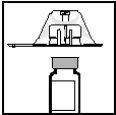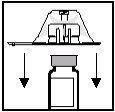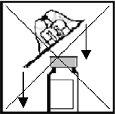
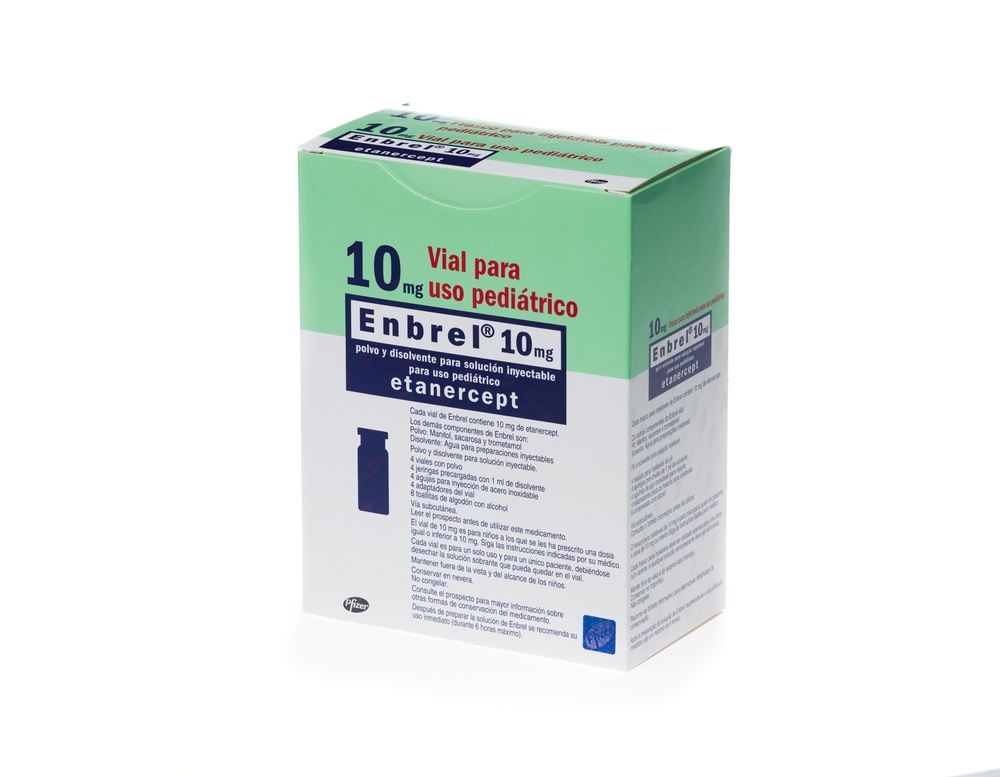
ЕНБРЕЛЬ 10 мг ПОРОШОК І РОЗЧИННИК ДЛЯ ПРИГОТУВАННЯ РОЗЧИНУ ДЛЯ ІН'ЄКЦІЙ ДЛЯ ПЕДІАТРИЧНОГО ЗАСТОСУВАННЯ


Інструкція із застосування ЕНБРЕЛЬ 10 мг ПОРОШОК І РОЗЧИННИК ДЛЯ ПРИГОТУВАННЯ РОЗЧИНУ ДЛЯ ІН'ЄКЦІЙ ДЛЯ ПЕДІАТРИЧНОГО ЗАСТОСУВАННЯ
Введення
Опис: інформація для користувача
Енбрел 10 мг порошок і розчинник для ін'єкційної розв'язки для педіатричного використання
етанерцепт
Прочитайте уважно весь опис перед тим, як почати використовувати цей лікарський засіб, оскільки він містить важливу інформацію для вас.
|
Зміст опису
Інформація, яка міститься в цьому описі, організована у наступних 7 розділах:
- Що таке Енбрел і для чого він використовується
- Що потрібно знати перед тим, як почати використовувати Енбрел
- Як використовувати Енбрел
- Можливі побічні ефекти
- Зберігання Енбрелу
- Зміст упаковки та додаткова інформація
- Інструкції з використання
1. Що таке Енбрел і для чого він використовується
Енбрел - це лікарський засіб, який виготовляється з двох людських білків. Він блокує дію іншого білка, який знаходиться в організмі, який викликає запалення. Енбрел діє шляхом зменшення запалення, пов'язаного з певними захворюваннями.
Енбрел призначений для лікування дітей та підлітків з наступними захворюваннями:
- Для наступних типів ювенільного ідіопатичного артриту, коли лікування метотрексатом не давало належного результату, або якщо метотрексат не підходить для дитини:
- Поліартрит (з позитивним або негативним ревматоїдним фактором) та олігоартрит, що поширюється, у пацієнтів віком від 2 років.
- Псоріатичний артрит у пацієнтів віком від 12 років.
- Для артриту, пов'язаного з ентезитом, у пацієнтів віком від 12 років, якщо використання інших лікарських засобів не давало належного результату, або якщо ці лікарські засоби не підходять для них.
- Важкий псоріаз у пацієнтів віком від 6 років, які мали недостатню реакцію на фототерапію або інші системні терапії.
2. Що потрібно знати перед тим, як почати використовувати Енбрел
Не використовуйте Енбрел
- якщо дитина, яка знаходиться під вашою опікою, алергічна на етанерцепт або на будь-який інший компонент Енбрелу (перелічені в розділі 6). Якщо дитина відчуває алергічні реакції, такі як стиснення грудної клітки, задишка, вертіг або висип, не вводьте більше Енбрелу і негайно проконсультуйтеся з вашим лікарем.
- якщо дитина має або має ризик розвитку важкої інфекції крові, такої як сепсис. Якщо ви не впевнені, проконсультуйтеся з вашим лікарем.
- якщо дитина має інфекцію будь-якого типу. Якщо ви не впевнені, проконсультуйтеся з вашим лікарем.
Попередження та застереження
Проконсультуйтеся з вашим лікарем перед тим, як почати використовувати Енбрел.
- Алергічні реакції:Якщо дитина відчуває алергічні реакції, такі як стиснення грудної клітки, задишка, вертіг або висип, не вводьте більше Енбрелу і негайно проконсультуйтеся з вашим лікарем.
- Латекс:Капсула шприца виготовлена з латексу (натуральної гуми). Проконсультуйтеся з вашим лікарем перед тим, як використовувати Енбрел, якщо шприц буде використовуватися або якщо Енбрел буде вводитися особі з відомою або можливою алергією на латекс.
- Інфекції/хірургія:Якщо дитина розвиває нову інфекцію або готується до великої хірургічної операції, лікар може бути зацікавлений у контролі лікування дитини Енбрелом.
- Інфекції/цукровий діабет:Повідомте вашому лікареві, якщо дитина має історію повторюваних інфекцій або якщо вона страждає цукровим діабетом або іншими захворюваннями, які збільшують ризик інфекції.
- Інфекції/мониторинг:Повідомте вашому лікареві про будь-які недавні поїздки за межі Європи. Якщо дитина розвиває симптоми інфекції, такі як гарячка, озноб або кашель, негайно повідомте про це вашому лікареві. Ваш лікар повинен вирішити, чи продовжувати моніторинг дитини на предмет інфекцій після припинення лікування Енбрелом.
- Туберкульоз:Оскільки були повідомлення про випадки туберкульозу у пацієнтів, які приймали Енбрел, ваш лікар повинен перевірити ознаки та симптоми туберкульозу перед тим, як почати лікування Енбрелом. Це може включати в себе ретельний огляд медичної історії, рентгенографію грудної клітки та тест на туберкульоз. Виконання цих тестів повинно бути зареєстровано в Картці інформації пацієнта. Дуже важливо, щоб ви повідомили вашому лікареві, якщо дитина мала туберкульоз або якщо вона була в безпосередньому контакті з людиною, яка мала туберкульоз. Якщо симптоми туберкульозу (такі як тривала кашель, втрату ваги, апатію, помірну гарячку) або будь-яка інша інфекція з'являються під час або після лікування, негайно повідомте про це вашому лікареві.
- Гепатит Б:Повідомте вашому лікареві, якщо дитина мала гепатит Б колись. Ваш лікар повинен провести тест на гепатит Б перед тим, як дитина почне лікування Енбрелом. Лікування Енбрелом може реактивувати гепатит Б у пацієнтів, які раніше були інфіковані вірусом гепатиту Б. Якщо це відбувається, потрібно припинити використання Енбрелу.
- Гепатит С:Повідомте вашому лікареві, якщо дитина має гепатит С. Ваш лікар може захотіти моніторити лікування Енбрелом у разі погіршення інфекції.
- Захворювання крові:Негайно повідомте вашому лікареві, якщо дитина має симптоми, такі як тривала гарячка, біль у горлі, синяки, кровотеча або блідість. Такі симптоми можуть вказувати на наявність важкого захворювання крові, яке вимагає припинення лікування Енбрелом.
- Захворювання нервової системи та зору:Повідомте вашому лікареві, якщо дитина має множинний склероз, неврит зору (запалення зорових нервів) або мієліт (запалення спинного мозку). Ваш лікар вирішить, чи підходить Енбрел для лікування.
- Серцева недостатність:Повідомте вашому лікареві, якщо дитина має історію серцевої недостатності, оскільки Енбрел потрібно використовувати з обережністю в таких випадках.
- Рак:Повідомте вашому лікареві, якщо дитина мала лімфому (тип раку крові) або будь-який інший рак перед тим, як дитина почне лікування Енбрелом.
Пацієнти з важким ревматоїдним артритом, які мали захворювання протягом тривалого часу, можуть мати підвищений ризик розвитку лімфоми.
Діти та дорослі, які приймають Енбрел, можуть мати підвищений ризик розвитку лімфоми або іншого раку.
Деякі підлітки та діти, які приймали Енбрел або інші лікарські засоби, які діють подібно до Енбрелу, мали випадки раку, включаючи рідкісні типи, які іноді призводили до смерті.
Деякі пацієнти, які приймали Енбрел, мали випадки раку шкіри. Повідомте вашому лікареві, якщо дитина має будь-які зміни на шкірі або пухлини на шкірі.
- Вітрянка:Повідомте вашому лікареві, якщо дитина була інфікована вітрянкою під час лікування Енбрелом. Ваш лікар вирішить, чи потрібно профілактичне лікування вітрянки.
- Алкоголізм:Енбрел не повинен використовуватися для лікування гепатиту, пов'язаного з алкоголізмом. Будь ласка, повідомте вашому лікареві, якщо дитина, яка знаходиться під вашою опікою, має історію алкоголізму.
- Вегенерська грануломатоз:Енбрел не рекомендується для лікування Вегенерської грануломатозу, рідкісного запального захворювання. Якщо дитина, яка знаходиться під вашою опікою, має Вегенерську грануломатоз, проконсультуйтеся з вашим лікарем.
- Протидіабетичні лікарські засоби:Повідомте вашому лікареві, якщо дитина має цукровий діабет або приймає лікарські засоби для лікування діабету. Ваш лікар може вирішити, чи потрібно зменшити дозу протидіабетичного лікарського засобу під час лікування Енбрелом.
Діти та підлітки
Вакцинація:Якщо це можливо, діти повинні мати всі вакцини перед тим, як почати лікування Енбрелом. Деякі вакцини, такі як оральна вакцина проти поліомієліту, не повинні вводитися під час лікування Енбрелом. Проконсультуйтеся з лікарем дитини перед тим, як вона використовуватиме будь-яку вакцину.
Зазвичай Енбрел не повинен використовуватися у дітей молодших 2 років з поліартритом або олігоартритом, у дітей молодших 12 років з артритом, пов'язаним з ентезитом, або псоріатичним артритом, а також у дітей молодших 6 років з псоріазом.
Інші лікарські засоби та Енбрел
Повідомте вашому лікареві або фармацевту, якщо дитина використовує, недавно використовувала або може використовувати будь-який інший лікарський засіб (включаючи анакінру, абатацепт або сульфасалазин), навіть якщо він не призначений лікарем дитини.
Вагітність та лактація
Енбрел повинен використовуватися під час вагітності тільки у разі явної необхідності. Проконсультуйтеся з вашим лікарем, якщо ви вагітні, думаєте, що можете бути вагітною або плануєте вагітність.
Якщо ви приймали Енбрел під час вагітності, ваша дитина може мати підвищений ризик інфекції. Крім того, у одному дослідженні було виявлено більше вад розвитку при прийомі Енбрелу під час вагітності порівняно з жінками, які не приймали Енбрел або інші подібні лікарські засоби (антагоністи TNF), але не було жодного шаблону вад розвитку. Інше дослідження не виявило підвищеного ризику вад розвитку при прийомі Енбрелу під час вагітності. Ваш лікар допоможе вам вирішити, чи переважують користі лікування потенційний ризик для вашої дитини.
Проконсультуйтеся з вашим лікарем, якщо ви хочете годувати грудьми під час лікування Енбрелом. Важливо повідомити педіатру та інших медичних працівників про використання Енбрелу під час вагітності та лактації перед тим, як ваша дитина отримає будь-яку вакцину.
Водіння транспортних засобів та використання машин
Не очікується, що використання Енбрелу вплине на вашу здатність водити транспортні засоби та використовувати машини.
3. Як використовувати Енбрел
Використання у дітей та підлітків
Слідуйте точно інструкціям з введення цього лікарського засобу, вказаним вашим лікарем. У разі сумніву проконсультуйтеся з вашим лікарем або фармацевтом.
Якщо ви вважаєте, що дія Енбрелу є надто сильною або слабкою, повідомте про це вашому лікареві або фармацевту.
Адекватна доза та частота введення залежатимуть від ваги дитини та захворювання. Лікар вказує, як діяти для підготовки та вимірювання адекватної дози.
Флакон 10 мг призначений для дітей, яким призначена доза рівна або нижча 10 мг. Кожен флакон призначений для одного використання та одного пацієнта, і будь-який залишковий розчин у флаконі повинен бути видалений.
Для поліартриту або олігоартриту, що поширюється, у пацієнтів віком від 2 років, або артриту, пов'язаного з ентезитом, або псоріатичного артриту у пацієнтів віком від 12 років, звичайна доза становить 0,4 мг Енбрелу на кілограм ваги дитини (до максимальної дози 25 мг) двічі на тиждень або 0,8 мг Енбрелу на кілограм ваги дитини (до максимальної дози 50 мг) один раз на тиждень.
Для псоріазу у пацієнтів віком від 6 років звичайна доза становить 0,8 мг Енбрелу на кілограм ваги дитини (до максимальної дози 50 мг) один раз на тиждень. Якщо Енбрел не має дії на захворювання дитини після 12 тижнів, лікар може вказати припинити використання цього лікарського засобу.
Форма та шлях введення
Енбрел вводиться шляхом ін'єкції під шкіру (підшкірної ін'єкції).
Енбрел можна вводити з або без їжі чи напоїв.
Порошок повинен бути розчинений перед використанням. Урозділі 7, "Інструкції з використання", наведені детальні інструкції для підготовки та введення Енбрелу.Розчин Енбрелу не повинен змішуватися з будь-яким іншим лікарським засобом.
Щоб вам допомогти запам'ятати, можна бути корисним записувати в щоденнику, які дні тижня потрібно вводити Енбрел.
Якщо ви використовуєте більше Енбрелу, ніж потрібно
Якщо ви використовуєте більше Енбрелу, ніж потрібно (або вводите велику кількість за один раз, або використовуєте його занадто часто), ви повинні проконсультуватися з лікарем або фармацевтом негайно. Завжди носіть з собою упаковку лікарського засобу, навіть якщо вона порожня.
Якщо ви забули ввести Енбрел
Якщо ви забули ввести дозу, ви повинні ввести її якнайшвидше, коли ви про це пам'ятайте, якщо тільки наступна доза не призначена на наступний день, у цьому випадку ви повинні пропустити забуту дозу. Потім продовжуйте вводити лікарський засіб у звичайний день.
Якщо ви припиняєте лікування Енбрелом
Ваші симптоми можуть повернутися після припинення лікування.
Якщо у вас є будь-які інші питання щодо використання цього лікарського засобу, проконсультуйтеся з вашим лікарем або фармацевтом.
4. Можливі побічні ефекти
Як і всі ліки, цей препарат може викликати побічні ефекти, хоча не всі люди їх відчувають.
Алергічні реакції
Якщо ви спостерігали будь-які з наступних реакцій у дитини, не давайте дитині більше Енбрел. Повідоміть про це своєму лікареві негайно або відвезіть дитину до відділення невідкладної допомоги найближчої лікарні.
- Відчуття труднощів при ковтанні або диханні.
- Набряк обличчя, горла, рук і ніг.
- Відчуття нервозності або тривоги, серцебиття, раптове почервоніння шкіри і/або відчуття жару.
- Важка висипка, свербіж або кропив'янка (видатні червоні або бліді висипки на шкірі, часто супроводжувані свербінням).
Важкі алергічні реакції рідкісні. Якщо дитина має будь-які з цих симптомів, це може бути ознакою алергічної реакції на Енбрел, тому вам потрібно негайно звернутися за медичною допомогою.
Важкі побічні ефекти
Якщо ви помітили будь-які з наступних ефектів, дитина може потребувати невідкладної медичної допомоги.
- Ознаки важних інфекцій, таких як висока температура, що супроводжується кашлем, задишкою, ознобом, слабістю або болючою, чутливою, червоною ділянкою шкіри або суглобів дитини.
- Ознаки порушень крові, таких як кровотеча, синяки або блідість.
- Ознаки порушень нервової системи, таких як оніміння або поколювання, порушення зору, біль в очах або появлення слабкості в руці чи нозі.
- Ознаки недостатності серця або погіршення недостатності серця, таких як втома або задишка під час діяльності, набряк гомілок, відчуття повноти в шиї або в животі, задишка вночі або кашель, синюшність нігтів дитини або навколо губ дитини.
- Ознаки раку: рак може вплинути на будь-яку частину тіла, включаючи шкіру та кров, і можливі ознаки залежать від типу та місця розташування раку. Ці ознаки можуть включати в себе втрату ваги, температуру, набряк (з болем або без), тривалий кашель, появлення шишок або загустень на шкірі.
- Ознаки автоімунних реакцій(при яких розвиваються антитіла, які можуть пошкодити нормальні тканини тіла) таких як біль, свербіж, слабість і дихання, мислення, відчуття або зір анормального.
- Ознаки люпуса або синдрому типу люпусатаких як зміни ваги, тривалий висип, температура, біль у м'язах або суглобах або втома.
- Ознаки воспалення кровітаких як біль, температура, почервоніння або жар шкіри, або свербіж.
Ці побічні ефекти рідкісні або малоймовірні, але вони є важкими станами (дехто з них рідко може бути смертельним). Якщо ці ознаки трапляються, повідоміть про це своєму лікареві негайно або зверніться до відділення невідкладної допомоги найближчої лікарні.
Наступні відомі побічні ефекти Енбрелу, згруповані за зменшенням частоти:
- Дуже часті(можуть впливати на більше ніж 1 з 10 осіб):
Інфекції (включно з застудою, синуситом, бронхітом, інфекціями сечовидільної системи та інфекціями шкіри); реакції на місці ін'єкції (включно з кровотечею, синяком, почервонінням, свербінням, болем та набряком) (не відбуваються так часто після першого місяця лікування; деякі пацієнти розвивали реакцію на місці ін'єкції, яку вони використовували нещодавно); та головний біль.
- Часті(можуть впливати до 1 з 10 осіб):
Алергічні реакції; температура; висипка; свербіж; антитіла, спрямовані проти нормальних тканин (утворення автоантитіл).
- Малоймовірні(можуть впливати до 1 з 100 осіб):
Важні інфекції (включно з пневмонією, інфекціями не поверхневої шкіри, інфекціями суглобів, інфекцією крові та загальними інфекціями); погіршення недостатності серця; низький рівень червоних кров'яних тіл, низький рівень білих кров'яних тіл, низький рівень нейтрофілів (тип білих кров'яних тіл); низький рівень пластинок; рак шкіри (крім меланоми); локалізований набряк шкіри (ангіоневротичний набряк); кропив'янка (видатні червоні або бліді висипки на шкірі, часто супроводжувані свербінням); запалення очей, псоріаз (новий або погіршення); запалення крові, що впливає на кілька органів; підвищення рівня печінкових ферментів у аналізах крові (у пацієнтів, які також приймають лікування метотрексатом, підвищення рівня печінкових ферментів є частим); спазми живота та біль, діарея, втрата ваги або кров у фекаліях (ознаки проблем з кишківником).
- Рідкісні(можуть впливати до 1 з 1 000 осіб):
Важкі алергічні реакції (включно з важким локалізованим набряком шкіри та задишкою); лімфома (тип кров'яного раку); лейкоз (рак, що впливає на кров та кістковий мозок); меланома (тип раку шкіри); поєднання низького рівня червоних кров'яних тіл, білих кров'яних тіл та пластинок; порушення нервової системи (із важким м'язевим слабінням та ознаками, подібними до множинного склерозу або запалення очних нервів чи спинного мозку); туберкульоз; недостатність серця; судоми; люпус або синдром типу люпуса (симптоми можуть включати тривалий висип, температуру, біль у суглобах та втому); висипка на шкірі, що може призвести до важкого утворення пухирів та лущення шкіри; лікеноподібні реакції (свербіжна червона-пурпурна висипка та/або товсті біло-сірі лінії на слизових оболонках); запалення печінки, викликані імунною системою (автоімунний гепатит; у пацієнтів, які також приймають лікування метотрексатом, частота є малоймовірною); імунологічний розлад, який може вплинути на легені, шкіру та лімфатичні вузли (саркоїдоз); запалення чи рубцювання легень (у пацієнтів, які також приймають лікування метотрексатом, частота запалення чи рубцювання легень є малоймовірною); пошкодження малих фільтрів всередині нирок, що призводить до порушення ниркової функції (гломерулонефрит).
- Дуже рідкісні(можуть впливати до 1 з 10 000 осіб):
Недостатність кісткового мозку для виробництва критичних кров'яних клітин.
- Частота невідома(не може бути оцінена з доступних даних):
Карцинома Меркеля (тип раку шкіри); саркома Капоші, рідкісний рак, пов'язаний з інфекцією вірусом людського герпесу 8. Саркома Капоші зазвичай проявляється як пурпурні шкіряні ураження; надмірна активація білих кров'яних тіл, пов'язана з запаленням (синдром активації макрофагів); реактивація гепатиту Б (інфекція печінки); погіршення захворювання, відомого як дерматоміозит (запалення та слабкість м'язів, супроводжувані висипкою на шкірі).
Інші побічні ефекти у дітей та підлітків
Побічні ефекти, спостережувані у дітей та підлітків, а також їх частота, подібні до тих, що описані вище.
Повідомлення про побічні ефекти
Якщо ви відчуваєте будь-який тип побічного ефекту, проконсультуйтеся з лікарем або фармацевтом, навіть якщо це можливі побічні ефекти, які не перелічені в цій інструкції. Ви також можете повідомити про них безпосередньо через систему фармакологічного нагляду за лікарськими засобами для людини: www.notificaRAM.es. Повідомляючи про побічні ефекти, ви можете допомогти надати більше інформації про безпеку цього лікарського засобу.
5. Зберігання Енбрелу
Тримати цей лікарський засіб поза зоною видимості та досягнення дітей.
Не використовувати цей лікарський засіб після закінчення терміну придатності, вказаного на упаковці після "EXP". Термін придатності - останній день місяця, який вказано.
Зберігати в холодильнику (2 °C - 8 °C). Не заморожувати.
Перед підготовкою розчину Енбрелу його можна зберігати поза холодильником при максимальній температурі 25 °C протягом одного періоду до 4 тижнів; після чого лікарський засіб не можна знову охолоджувати. Енбрел слід викинути, якщо він не був використаний протягом 4 тижнів після видалення з холодильника. Рекомендується, щоб ви записали дату, коли Енбрел був видалений з холодильника, та дату, з якої Енбрел слід викинути (не пізніше 4 тижнів після видалення упаковки з холодильника). Ця нова дата не повинна перевищувати термін придатності, вказаний на упаковці.
Після підготовки розчину Енбрелу рекомендується негайне використання. Однак розчин можна використовувати протягом 6 годин, якщо його зберігати при максимальній температурі 25 °C.
Не використовувати цей лікарський засіб, якщо ви спостерігали, що розчин не є прозорим або містить частинки. Розчин повинен бути прозорим, безколірним або злегка жовтим чи коричневим, без грудок, лусочок чи частинок.
Лікарські засоби не слід викидати у водопровідні труби чи сміття. Спитайте у свого фармацевта, як позбутися упаковок та лікарських засобів, які вам вже не потрібні. Таким чином, ви допоможете захистити навколишнє середовище.
6. Зміст упаковки та додаткова інформація
Склад Енбрел
Активним інгредієнтом Енбрел є етанерцепт. Кожна флакона Енбрел 10 мг порошок і розчинник для ін'єкційного розчину для педіатричного використання містить 10 мг етанерцепту. Після відновлення розчин містить 10 мг/мл етанерцепту.
Інші компоненти:
Порошок: Манітол (Е421), сукроза і трометамол.
Розчинник: Вода для ін'єкційних препаратів.
Вигляд продукту та вміст упаковки
Енбрел 10 мг порошок і розчинник для ін'єкційного розчину для педіатричного використання випускається у вигляді білого порошку з розчинником для ін'єкційного розчину (порошок для ін'єкцій). Кожна упаковка містить 4 флакони, 4 предварительно заповнені шприци з водою для ін'єкційних препаратів, 4 голки, 4 адаптери для флаконів і 8 ватних тампонів з алкоголем.
Власник дозволу на розміщення продукції на ринку: Pfizer Europe MA EEIG Бульвар де ла Плейн 17 1050 Брюссель Бельгія | |
Виробник: Pfizer Manufacturing Belgium NV Рейксьвей 12, 2870 Пурс-Сінт-Амандс Бельгія |
Для отримання додаткової інформації щодо цього лікарського засобу зверніться до місцевого представника власника дозволу на розміщення продукції на ринку:
Іспанія
Pfizer, S.L.
Телефон: +34 91 490 99 00
Дата останнього перегляду цієї інструкції:
Детальна інформація про цей лікарський засіб доступна на сайті Європейського агентства з лікарських засобів: http://www.ema.europa.eu.
- Інструкції з використання
Ця секція розділена на наступні розділи:
- Вступ
- Підготовка до ін'єкції
- Підготовка дози Енбрел для ін'єкції
- Додавання розчинника
- Видалення розчину Енбрел з флакону
- Кріплення голки до шприца
- Вибір місця ін'єкції
- Підготовка місця ін'єкції та введення розчину Енбрел
- Видалення матеріалів
- Вступ
Наступні інструкції пояснюють, як підготувати та ввести Енбрел. Важливо прочитати інструкції та слідувати їм крок за кроком. Лікар дитини або медсестра навчит вас правильній техніці введення ін'єкції та кількості лікарського засобу, яку потрібно вводити дитині. Не намагайтесь вводити ін'єкцію дитині, поки не будете впевнені, що розумієте, як підготувати та ввести ін'єкцію.
Ця ін'єкція не повинна змішуватися в одному шприці або флаконі з будь-яким іншим лікарським засобом. Дивіться розділ 5 для отримання інформації про зберігання Енбрел.
- Підготовка до ін'єкції
- Ви мите руки.
- Виберіть плоску, чисту та добре освітлену поверхню.
- Тарілка повинна містити всі наступні елементи. (Якщо якийсь із цих елементів відсутній на тарілці, не використовуйте тарілку та зверніться до вашого фармацевта). Використовуйте лише перелічені елементи. НІвикористовуйте жоден інший шприц.
1 флакон Енбрел
1 предварительно заповнений шприц з прозорим та безбарвним розчинником (вода для ін'єкційних препаратів)
1 голка
1 адаптер для флакону
2 ватних тампони з алкоголем
- Перевірте термін придатності на етикетках флакону та шприца. Не повинні використовуватися після місяця та року, вказаних на них.
- Підготовка дози Енбрел для ін'єкції
- Видаліть вміст тарілки.
- Зніміть пластикову кришку з флакону Енбрел (див. Фігура 1). НІзніміть сіру кришку або алюмінієву обойму, яка оточує верхню частину флакону.
Фігура 1
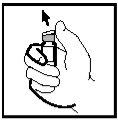
- Використайте новий ватний тампон з алкоголем, щоб очистити сіру кришку флакону Енбрел. Після очищення не торкайтеся кришки руками та уникайте її контакту з будь-якою поверхнею.
- Помістіть флакон у вертикальному положенні та зверху на плоску та чисту поверхню.
- Видаліть папір, який покриває упаковку адаптера для флакону.
- Тримаючи його ще в пластиковій упаковці, помістіть адаптер для флакону на верхню частину флакону Енбрел так, щоб голка адаптера була центрована всередині кола, яке з'являється на верхній частині кришки флакону (див. Фігура 2).
Фігура 2 | Фігура 3 | Фігура 4 |
|
|
|
ВІДПОВІДНО | НЕВІДПОВІДНО |
- Тримаючи флакон міцно однією рукою на плоскій поверхні, поштовхніть упаковку адаптера ПРЯМОдо тих пір, поки не відчуєте, що голка адаптера проникає в кришку флакону та ДО ТИХ ПІР, ПОКИ НЕ ВЧУВСТЕ І ПОЧУЙЕТЕ, ЩО БОРТ АДАПТЕРА ЗАМКНУВСЯ НА СВОБІ МІСЦІ(див. Фігура 3). НІпоштовхніть адаптер під кутом (див. Фігура 4). Важливо, щоб голка адаптера для флакону повністю проникла в кришку флакону.
- Тримаючи флакон в одній руці, видаліть пластикову упаковку адаптера для флакону (див. Фігура 5).
Фігура 5

- Видаліть захисний ковпачок з кінця шприца, зламавши білу кришку уздовж перфорації. Це здійснюється шляхом утримання кільця білої кришки однією рукою, а другою рукою тримаючи кінець білої кришки та згинаючи його вгору та вниз до тих пір, поки він не зламається (див. Фігура 6). НІвидаліть біле кільце, яке залишається прикріпленим до шприца.
Фігура 6
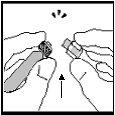
- Не використовуйте шприц, якщо перфорування між кінцем та кільцем кришки вже зламане. Почніть заново з іншої упаковки дози.
- Тримаючи скляний корпус шприца (не біле кільце) в одній руці та адаптер для флакону (не флакон) в іншій руці, під'єднайте шприц до адаптера для флакону, вставивши кінець у отвір та повернувши за годинниковою стрілкою до тих пір, поки він не буде повністю закріплений (див. Фігура 7).
Фігура 7
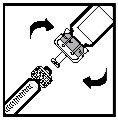
- Додавання розчинника
- Тримаючи флакон у вертикальному положенні на плоскій поверхні, поштовхніть поршень ДОБРЕповільно до тих пір, поки весь розчинник не потрапить у флакон. Це допоможе зменшити утворення піни (багато бульбашок) (див. Фігура 8).
- Після того, як розчинник буде доданий до Енбрел, поршень може рухатися самостійно. Це відбувається через тиск повітря та не є причиною для занепокоєння.
Фігура 8
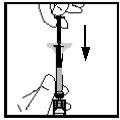
- З шприцем, ще вставленим, повільно рухайте флакон по колу кілька разів, щоб розчинити порошок (див. Фігура 9). НІпотрясайте флакон. Чекайте, поки весь порошок не розчиниться (зазвичай менше 10 хвилин). Розчин повинен бути прозорим та безбарвним або мати світло-жовтий або світло-коричневий колір, без грудок, лусочок або частинок. Нормально, якщо залишаються білі піни на флаконі. НІвикористовуйте Енбрел, якщо весь порошок з флакону не розчиниться за 10 хвилин. Почніть заново з іншої упаковки дози.
Фігура 9
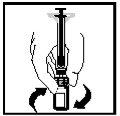
- Видалення розчину Енбрел з флакону
- Лікар або медсестра вказали вам правильну кількість розчину, який потрібно видалити з флакону. Якщо лікар не надав цих вказівок, зверніться до нього.
- З шприцем, ще вставленим у флакон та адаптер, тримаючи флакон у перевернутому положенні на рівні очей. Поштовхніть поршень повністю всередину шприца (див. Фігура 10).
Фігура 10
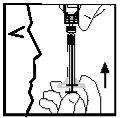
- Потім повільно витягніть поршень назад, щоб видалити рідину з шприца (див. Фігура 11). Видаліть лише частину рідини, яку лікар дитини вказав вам. Після видалення Енбрел з флакону можете знайти деяке повітря в шприці. Не турбуйтеся, оскільки повітря буде видалено на останньому етапі.
Фігура 11
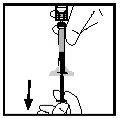
- Тримаючи флакон у перевернутому положенні, від'єднайте шприц від адаптера для флакону, повернувши його проти годинникової стрілки (див. Фігура 12).
Фігура 12
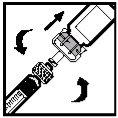
- Помістіть наповнений шприц на чисту та плоску поверхню. Перевірте, щоб кінець не торкався нічого. Будьте обережні, щоб не натиснути поршень вниз.
- Кріплення голки до шприца
- Голка поставляється в пластиковій упаковці, щоб保持ати її стерильністю.
- Для відкриття пластикової упаковки тримають коротшу та ширшу частину в одній руці. Помістіть іншу руку на довшу частину упаковки.
- Для зламу упаковки згиніть довший кінець вгору та вниз до тих пір, поки він не зламається (див. Фігура 13).
Фігура 13
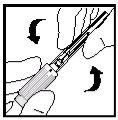
- Після зламу упаковки видаліть коротшу та ширшу частину пластикової упаковки.
- Голка залишається в довшій частині упаковки.
- Тримаючи голку та упаковку в одній руці, візьміть шприц та вставьте його кінець у отвір голки.
- Вставьте шприц у голку, повернувши його за годинниковою стрілкою до тих пір, поки він не буде повністю закріплений (див. Фігура 14).
Фігура 14
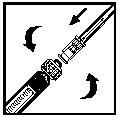
- Видаліть захисний ковпачок з голки шприца, потягнувши його міцно та уникнувши контакту з голкою та будь-якою поверхнею (див. Фігура 15). Будьте обережні, щоб не згинати чи торкатися ковпачка, щоб не пошкодити голку
Фігура 15
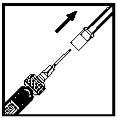
- Тримаючи шприц у вертикальному положенні, видаліть бульбашки, поштовхнувши поршень повільно до тих пір, поки повітря не буде видалено (див. Фігура 16).
Фігура 16
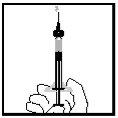
- Вибір місця ін'єкції
- Три рекомендовані місця для ін'єкції Енбрел включають: (1) центральну передню частину стегон; (2) живіт, крім області 5 см навколо пупка; та (3) зовнішню верхню частину рук (див. Фігура 17). Якщо дитина робить ін'єкцію самостійно, не повинна робити це на зовнішній верхній частині рук.
Фігура 17
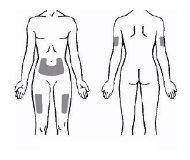
- Повинно бути використано інше місце для кожної нової ін'єкції. Кожна нова ін'єкція повинна бути зроблена не менше ніж за 3 см від місця попередньої ін'єкції. Невводіть в області шкіри, що є чутливими, забрудненими, червоними або загрубілими. Уникайте областей з рубцями або стріями. (Можливо, буде корисно, якщо ви зробите нотатки про місця попередніх ін'єкцій).
- Якщо дитина має псоріаз, спробуйте не вводити прямо в будь-яку область шкіри, що є товстою, червоною або лускатою ("псоріатичні ураження шкіри").
- Підготовка місця ін'єкції та введення розчину Енбрел
- Очистіть місце ін'єкції, де ви будете вводити Енбрел, новим ватним тампоном з алкоголем, рухаючи його по колу. НІторкайтеся цієї області знову до тих пір, поки не буде зроблена ін'єкція.
- Коли попередньо очищена шкіра висохне, однією рукою потягніть її та тримають міцно. Іншою рукою тримають шприц, як олівець.
- З швидким та коротким рухом, поштовхніть голку до кінця, проникаючи в шкіру під кутом 45° до 90° (див. Фігура 18). З практикою, ви знайдете кут, який є найбільш зручним для дитини. Будьте обережні, щоб не поштовхнути голку в шкіру занадто повільно або з великою силою.
Фігура 18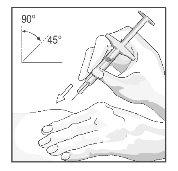
- Коли голка буде повністю вставлена в шкіру, відпустіть шкіру, яку ви тримаєте. Вільною рукою тримають голку біля її основи, щоб стабілізувати її. Потім поштовхніть поршень, щоб ввести весь розчин з ПОВІЛЬНОЮта постійною швидкістю (див. Фігура 19).
Фігура 19
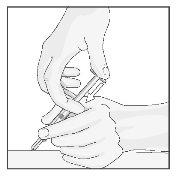
- Коли шприц буде порожнім, видаліть голку зі шкіри; будьте обережні, щоб тримати шприц під тим же кутом, під яким він був вставлений.
- Натисніть на місце ін'єкції ватним тампоном протягом 10 секунд. Можливо, буде легке кровотеча. НІтертіть місце ін'єкції. Якщо хочете, можете накласти пов'язку.
- Видалення матеріалів
- Шприц та голка НІКОЛИне повинні бути повторно використані. Видаліть голку та шприц, слідуючи вказівкам лікаря, медсестри або фармацевта.
Якщо у вас є питання, зверніться до лікаря, медсестри або фармацевта, які знайомі з використанням Енбрел.
- Країна реєстрації
- Діючі речовини
- Потрібен рецептТак
- Виробник
- Інформація є довідковою і не є медичною порадою. Перед прийомом будь-яких препаратів обов'язково проконсультуйтеся з лікарем. Oladoctor не несе відповідальності за медичні рішення, прийняті на основі цього контенту.
- Альтернативи до ЕНБРЕЛЬ 10 мг ПОРОШОК І РОЗЧИННИК ДЛЯ ПРИГОТУВАННЯ РОЗЧИНУ ДЛЯ ІН'ЄКЦІЙ ДЛЯ ПЕДІАТРИЧНОГО ЗАСТОСУВАННЯФорма випуску: РОЗЧИН ДЛЯ ІН'ЄКЦІЙ, 25 мгДіючі речовини: etanerceptВиробник: Samsung Bioepis Nl B.V.Потрібен рецептФорма випуску: ІН'ЄКЦІЙНИЙ, 50 мгДіючі речовини: etanerceptВиробник: Samsung Bioepis Nl B.V.Потрібен рецептФорма випуску: РОЗЧИН ДЛЯ ІН'ЄКЦІЙ, 50 мгДіючі речовини: etanerceptВиробник: Samsung Bioepis Nl B.V.Потрібен рецепт
Аналоги ЕНБРЕЛЬ 10 мг ПОРОШОК І РОЗЧИННИК ДЛЯ ПРИГОТУВАННЯ РОЗЧИНУ ДЛЯ ІН'ЄКЦІЙ ДЛЯ ПЕДІАТРИЧНОГО ЗАСТОСУВАННЯ в інших країнах
Найкращі аналоги з тією самою діючою речовиною та терапевтичним ефектом.
Аналог ЕНБРЕЛЬ 10 мг ПОРОШОК І РОЗЧИННИК ДЛЯ ПРИГОТУВАННЯ РОЗЧИНУ ДЛЯ ІН'ЄКЦІЙ ДЛЯ ПЕДІАТРИЧНОГО ЗАСТОСУВАННЯ у Україна
Лікарі онлайн щодо ЕНБРЕЛЬ 10 мг ПОРОШОК І РОЗЧИННИК ДЛЯ ПРИГОТУВАННЯ РОЗЧИНУ ДЛЯ ІН'ЄКЦІЙ ДЛЯ ПЕДІАТРИЧНОГО ЗАСТОСУВАННЯ
Консультація щодо дозування, побічних ефектів, взаємодій, протипоказань та поновлення рецепта на ЕНБРЕЛЬ 10 мг ПОРОШОК І РОЗЧИННИК ДЛЯ ПРИГОТУВАННЯ РОЗЧИНУ ДЛЯ ІН'ЄКЦІЙ ДЛЯ ПЕДІАТРИЧНОГО ЗАСТОСУВАННЯ – за рішенням лікаря та згідно з місцевими правилами.



